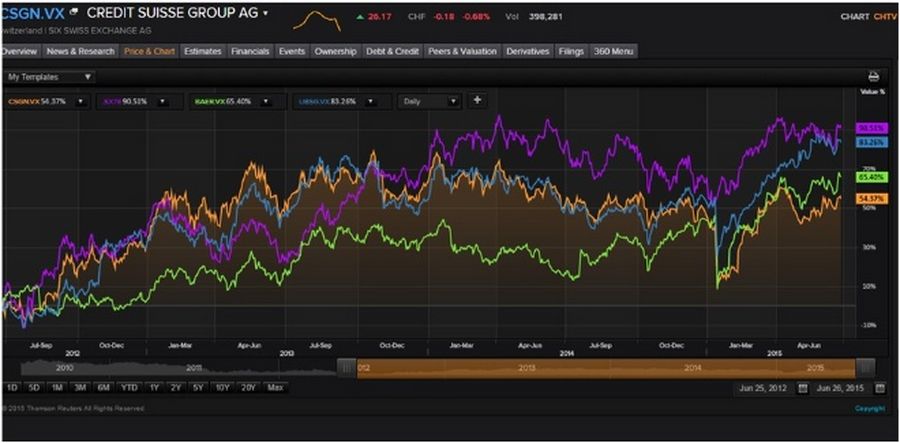Credit Suisse’s new chief executive needs to pass the cap before he can think big. Tidjane Thiam, who starts on July 1, is likely to use two main levers to shake up the Swiss bank: bulking up in wealth management, and scaling down in investment banking. But he needs 5 billion Swiss francs ($5.3 billion) via a rights issue first.
The Swiss bank’s weak capital position is a strategic straitjacket. Credit Suisse’s risk-weighted and gross asset common equity ratios were respectively 10 percent and 2.6 percent at the end of March – the bare minimum investors consider acceptable. The bank thus has scant firepower for acquisitions, and its stock has underperformed all continental European peers bar Deutsche Bank since 2012.
Credit Suisse can raise 2.6 billion Swiss francs through an overnight placing, without consulting shareholders. But that wouldn’t get the bank to the 4 percent and 12 percent ratios investors now expect. Pending Basel IV rules that affect investment banking trading businesses will make its risk-weighted metric look even worse – they could hike Credit Suisse’s RWAs by 21 percent, reckons KBW.
Meanwhile, Credit Suisse’s investment bank consumes a bigger slice of group capital than its performance warrants. The businesses that outgoing Chief Executive Brady Dougan kept Credit Suisse in did generate a 19 percent first-quarter return on equity. But the wealth management unit produced a higher 24 percent return, and investment banking peers are more efficient still. Arch-rival UBS achieved just 8 percent less in investment banking pre-tax profit last year despite having less than half the risk-weighted assets.
Still, the acceptable performance suggests Thiam shouldn’t decommission the unit entirely. As Royal Bank of Scotland has found, shuttering an investment bank is usually costly. Seeking a merger with the division of a rival, like Deutsche Bank or UBS, is unlikely to fly with regulators still wary of big investment banks.
Shrinking further would therefore be wise. Credit Suisse’s fixed income trading prowess in recent years has come in securitisation and credit, as investors have sought higher-yielding products in the low rate environment. These two businesses are among the worst hit by Basel IV rules.
Thiam might secure a reasonable price for selling the securitisation business whole. Combined with reducing Credit Suisse’s credit trading portfolio and prime services unit, that could result in a fall in risk-weighted assets to 100 billion Swiss francs from 149 billion at the end of March. It would also imply at least an extra 150 billion Swiss franc drop in the group’s leverage exposure. Add that to the 5 billion Swiss francs in fresh capital and Credit Suisse would be left with a respectable 11.8 percent CET1 ratio and 4 percent common equity leverage ratio assuming that the 21 percent increase in RWAs was taken up front.
Credit Suisse’s investment bank would thus be a touch larger than UBS’s, but in the same mould. Wealthy clients and entrepreneurs would have access to trading in equities, foreign exchange and basic interest rate products on the one hand, and advisory know-how for corporate capital raising on the other.
Thiam would then be free to invest in wealth management, which he rightly sees as offering better prospects for growth. His choice would then be whether to pull out the stops for a blockbuster acquisition in Asia, as he tried to do as Prudential CEO by bidding for rival insurer AIA; or to grow Credit Suisse’s private bank from the ground up both in Asia and Latin America, where it has a strong presence in Brazil.
The snag is that there are few AIA-like equivalents. Most of Credit Suisse’s main rivals in Asian wealth management are other, bigger banks. DBS Bank of Singapore is only slightly smaller, with a market capitalisation of around $40 billion. That leaves the perennial bid rumour, Swiss private banking rival Julius Baer. Though a much larger rights issue could give Thiam the war chest to countenance a bid, he would be paying up. Baer trades on 2.3 times book value, more than double that of Credit Suisse.
One alternative, floated by Berenberg analysts, might be for Thiam to approach new Standard Chartered Chief Executive Bill Winters. StanChart’s $45 billion of Asian private banking assets under management could propel Credit Suisse close to standout leaders UBS and Citigroup, and Winters could be open to a deal given he is conducting a strategic review. Winters, though, may want to hang on to the chance to grow in a business and region that offer promising returns.
Any of these options looks feasible for Thiam. But none will work without a swift recapitalisation.
